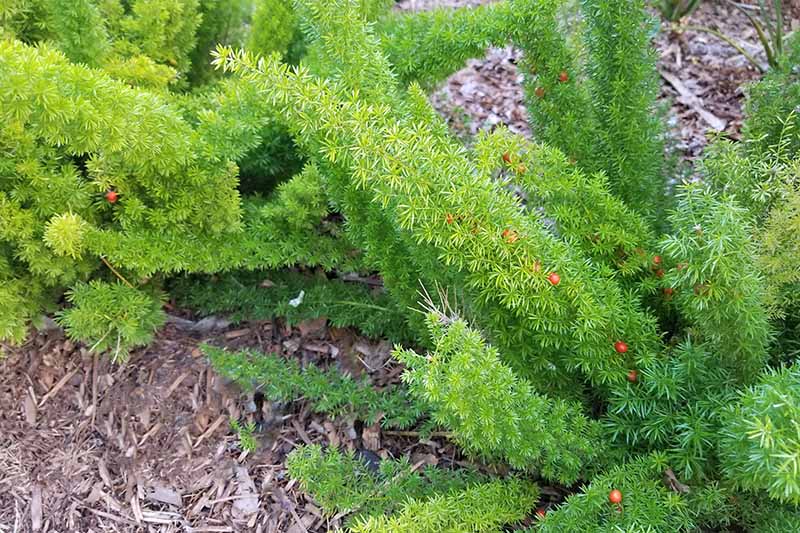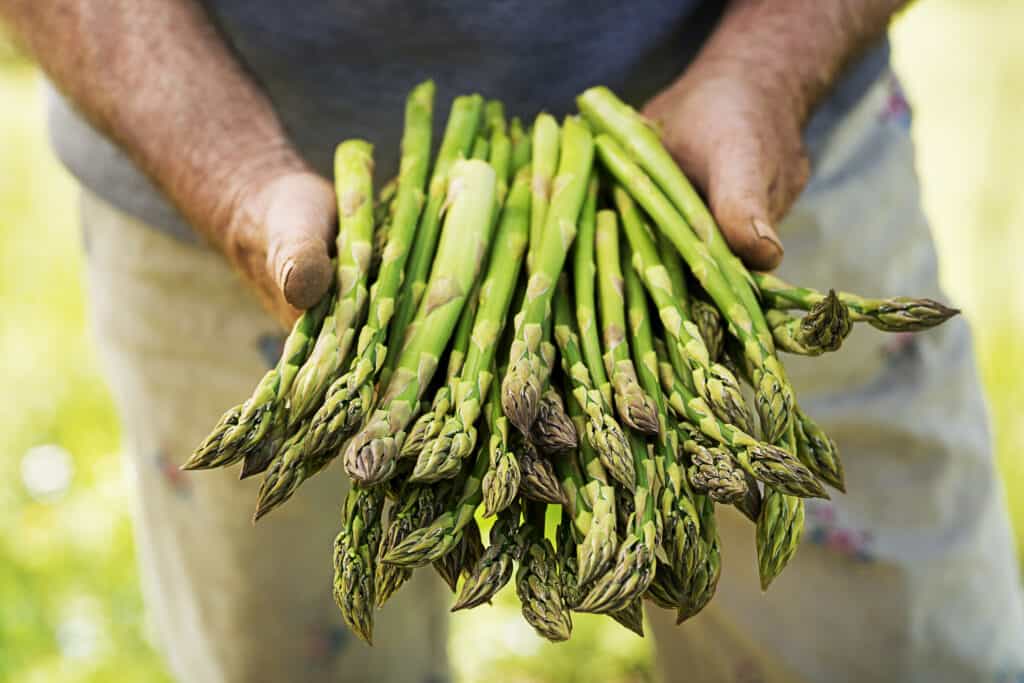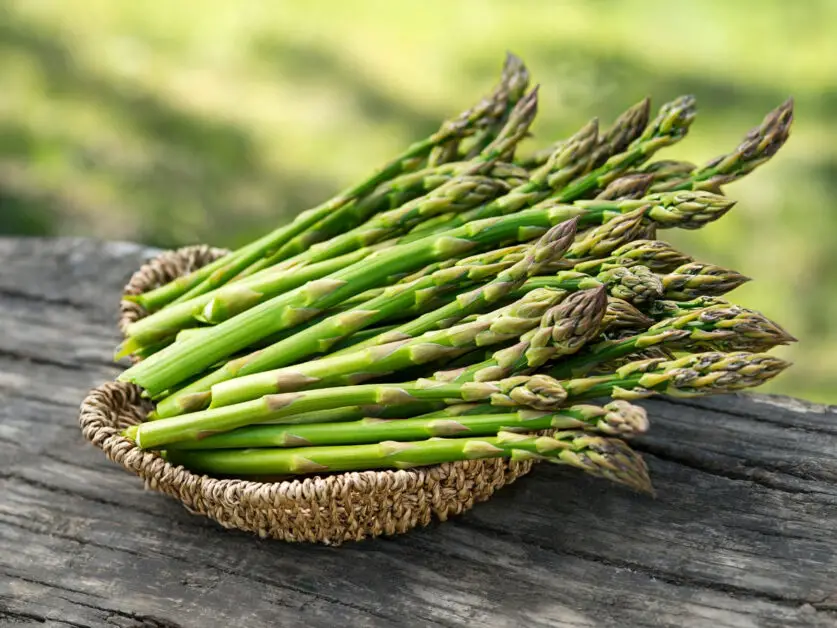Asparagus Adventure: How to Grow Spiky Spears
Are you ready to embark on an asparagus adventure? Picture this: tender, succulent spears bursting with flavor, grown right in your backyard. But hold on, before you dive into the world of cultivating these spiky delights, let’s get down to the nitty-gritty of how to grow them like a pro. From soil preparation to harvesting techniques, we’ve got you covered with the latest tips and tricks. Asparagus may seem intimidating, but with the right guidance, you’ll be reaping the rewards in no time. So, grab your gardening gloves and join us as we unravel the secrets to a bountiful asparagus harvest. Get ready to elevate your garden game and savor the taste of homegrown goodness. Let’s dive in!
Table of Contents
Selecting the Right Asparagus Varieties for Your Garden
When it comes to selecting the right asparagus varieties for your garden, there are a few important factors to consider.
| Variety | Advantages | Disadvantages | Characteristics |
|---|---|---|---|
| Green | – Common Choice: Widely available and popular. – Versatile: Suitable for various cooking methods. | – Tougher Texture: Can be slightly tougher than other varieties. – Strong Flavor: Intense asparagus taste. | – Color: Bright green spears. – Texture: Firm and crisp. – Flavor: Earthy and grassy. |
| White | – Delicate Flavor: Mild and subtle taste. – Tender Texture: Less fibrous than green asparagus. | – Challenging Harvest: Requires mounding soil to prevent sunlight exposure (blanching). – Less Common: Not as widely available. | – Color: Pale white or cream spears. – Texture: Tender and smooth. – Flavor: Mild and sweet. |
| Purple | – Unique Appearance: Eye-catching purple color. – Slightly Sweet: Sweeter flavor than green. | – Smaller Size: Spears are smaller than green or white asparagus. – Limited Availability: Less common in stores. | – Color: Vibrant purple or violet spears. – Texture: Similar to green asparagus. – Flavor: Sweet. |
Overall, selecting the right asparagus varieties for your garden involves finding a variety that will thrive in your specific growing conditions, fits within the space you have available, and suits your flavor preferences. By taking these factors into account, you’ll be well on your way to enjoying a successful and bountiful asparagus harvest.
Understanding the Ideal Growing Conditions for Asparagus
Asparagus is a vegetable that thrives in specific growing conditions, and understanding these requirements is essential for successful cultivation.

- Sun Exposure: Asparagus thrives in full sun, needing 6 to 8 hours of direct sunlight daily for optimal growth.
- Well-Drained Soil: Ensure the soil is well-drained to prevent root rot. Sandy loam or loamy soil types are best suited for asparagus cultivation.
- Soil pH: Maintain a pH level between 6.0 and 7.0, slightly acidic to neutral, to promote nutrient availability and absorption by the roots.
- Soil Testing: Conduct a soil test before planting to determine the pH level. Adjust the pH by adding lime to raise it or sulfur to lower it, ensuring ideal conditions for asparagus growth and productivity.
Preparing the Soil for Asparagus Planting
Preparing the soil is a crucial step in successfully growing asparagus. The right soil conditions will provide the necessary nutrients and optimal drainage for healthy plant growth. Before planting, it is essential to assess and prepare the soil to create an ideal environment for your asparagus bed.
:max_bytes(150000):strip_icc()/how-to-plant-and-grow-asparagus-1402814-01-8a911ee605434ccfaebdffa4d435cb32.jpg)
- Soil pH: Aim for a pH range of 6.0 to 7.0, crucial for asparagus growth. Conduct a soil test to determine the current pH level and adjust as needed.
- pH Adjustment: Use lime to raise pH if too low; sulfur or other acidifying agents can lower pH if too high.
- Organic Matter: Incorporate compost, well-rotted manure, or other organic matter into the soil to improve structure and moisture retention.
- Nutrient Enhancement: Organic matter boosts soil nutrient content, providing essential elements for asparagus plants.
- Weed Control: Clear the planting area of existing vegetation and weeds to minimize competition for nutrients and water.
- Preparation for Planting: Proper soil preparation ensures a solid foundation for healthy asparagus growth and a fruitful harvest.
Planting Asparagus Crowns: Step-by-Step Guide
Planting asparagus crowns is a crucial step in establishing a successful asparagus bed. To ensure healthy growth and a bountiful harvest, follow this step-by-step guide:
Step 1: Prepare the soil
Asparagus thrives in well-drained soil with a pH between 6.0 and 7.0. Start by removing any weeds or grass from the planting area. Loosen the soil to a depth of at least 12 inches, incorporating organic matter such as compost or aged manure. This will improve the soil’s fertility and drainage, creating an optimal environment for asparagus roots.
Step 2: Dig trenches
Next, dig trenches that are 6 to 8 inches deep and 12 to 18 inches wide. Space the trenches about 3 to 4 feet apart, allowing enough room for the asparagus crowns to mature. Asparagus is a perennial vegetable, so proper spacing is essential for its long-term growth and productivity.
Step 3: Place and cover the crowns
Gently spread the roots of the asparagus crowns at the bottom of the trench, ensuring they are facing downwards. Space the crowns about 12 to 18 inches apart within the trench. Cover the crowns with 2 to 3 inches of soil, leaving the remaining trench unfilled.
Step 4: Gradual filling
As the asparagus plants start growing, continue filling the trenches gradually over time. As the young shoots emerge, add more soil until the trench is completely filled. This gradual filling helps prevent damage to the emerging spears and encourages the development of sturdy, well-established plants.
Step 5: Mulch and water
After filling the trenches, apply a layer of organic mulch, such as straw or wood chips, around the asparagus plants. This will help suppress weeds, conserve moisture, and improve the soil’s structure. Regularly water the asparagus bed, ensuring the soil is consistently moist but not waterlogged.
Following these step-by-step instructions will set you on the path to a thriving asparagus bed. Remember to be patient, as asparagus takes time to establish, but the rewards of homegrown spears will be well worth the wait.
Maintaining Proper Watering Techniques for Healthy Asparagus Growth
Proper watering techniques are crucial for maintaining healthy asparagus growth in your garden. Asparagus plants require consistent moisture throughout their growing season, but overwatering can lead to root rot and other diseases. It is important to strike a balance and provide just the right amount of water to ensure optimal growth.
- Drip Irrigation:
- Advantages:
- Delivers water directly to the soil, minimizing waste.
- Avoids wetting the foliage, reducing the risk of fungal diseases.
- Ensures thorough coverage by spacing emitters evenly along the bed.
- Disadvantages:
- Initial setup and installation may require effort.
- Requires a drip irrigation system.
- Characteristics:
- Penetrates deep into the soil, reaching the roots where it’s needed most.
- Advantages:
- Timing:
- Ideal Times: Water in the early morning or late afternoon.
- Allows plants to absorb moisture before daytime heat evaporates it.
- Helps prevent fungal issues by allowing foliage to dry before nightfall.
- Monitoring: Regularly check soil moisture by inserting your finger into the ground.
- If the top inch of soil feels dry, it’s time to water.
- Ideal Times: Water in the early morning or late afternoon.
- Water Requirements:
- Asparagus generally needs about 1 to 1.5 inches of water per week.
- Adjust based on your specific climate and soil conditions.
Remember to combine proper watering techniques with other essential practices for successful asparagus cultivation. Happy growing! 🌱🍽️
Mulching and Weed Control for Asparagus Beds
Mulching and weed control are crucial aspects of maintaining healthy asparagus beds. By implementing effective mulching techniques and controlling weed growth, gardeners can ensure the optimum growth and productivity of their asparagus plants.Mulching serves various purposes when it comes to asparagus cultivation.
- Weed Suppression: Mulching blocks sunlight and prevents weed seeds from germinating, reducing weed growth in the asparagus bed.
- Moisture Retention: Mulch helps retain soil moisture, reducing the need for frequent watering and providing a stable environment for asparagus roots.
- Organic Material: Choose organic mulch materials like straw, wood chips, or compost to enrich the soil with nutrients as they decompose.
- Timing: Wait until asparagus plants reach 6 to 8 inches in height before applying mulch.
- Application: Spread a layer of organic mulch evenly around the base of the plants, avoiding contact with the stems to prevent rotting.
- Monitoring and Maintenance: Regularly check the mulch to prevent compaction, which can restrict water and air circulation. Adjust and replenish mulch as needed to maintain optimal conditions for asparagus growth.
By implementing proper mulching techniques, gardeners can effectively suppress weed growth and provide optimal growing conditions for their asparagus beds.
Fertilizing Asparagus: Tips for Feeding Your Plants
When it comes to growing healthy and vibrant asparagus plants, proper fertilization is key.
- Asparagus is a nutrient-hungry crop that requires balanced and consistent feeding to reach its full potential.
- By understanding the specific nutrient needs of asparagus and implementing an effective fertilization regimen, you can ensure a bountiful harvest year after year.
- One of the first steps in fertilizing asparagus is to conduct a soil test to determine the nutrient composition of your soil.
- This will help you understand which nutrients are lacking and need to be supplemented.
- Asparagus typically requires a soil pH between 6.0 and 7.0, so if your soil falls outside of this range, you may need to adjust it using soil amendments such as lime or sulfur.
Protecting Asparagus from Pests and Diseases
Protecting asparagus plants from pests and diseases is crucial to ensure a healthy and productive harvest.
| Disease | Symptoms | Treatment | Effects on Plants |
|---|---|---|---|
| Purple Spot | – Sunken, purple, oval-shaped lesions on asparagus spears. – Tan to brown lesions on the fern. | – Scout fields for symptoms. – Use disease forecasters to time fungicide applications. – Refer to recommended fungicides. | – Reduced spear quality and yield. – Increased susceptibility to other pathogens. – Shortened plant lifespan. |
| Rust | – Foliar disease with four different lesion types. | – Remove infected foliage. – Apply fungicides if necessary. | – Reduced photosynthesis and carbohydrate reserves. – Decreased spear quality. |
| Fusarium Crown and Root Rot | – Yellowing, wilting, and stunted growth. – Brown discoloration of roots. | – Treat seeds with hot water or disinfectants. – Avoid planting where asparagus has been grown recently. – Limit excessive cutting periods. | – Weakened plants and reduced regeneration ability. |
If you notice any signs of disease, it is crucial to remove and destroy infected plants immediately to prevent further spread. Applying fungicides labeled for asparagus disease control can be beneficial, but make sure to follow the manufacturer’s instructions and adhere to any safety precautions.
Managing Asparagus Ferns: How to Control Their Growth
Asparagus ferns, also known as “asparagus grass” or “ferny shoots,” are a common sight in many asparagus beds. Although these feathery green fronds may add a touch of elegance to your garden, they can also become a nuisance if left unchecked. Fortunately, there are several strategies you can employ to manage the growth of asparagus ferns and ensure the optimal health and productivity of your asparagus plants.

- Regular Pruning: Prune asparagus ferns when they begin to yellow and turn brown at the end of the growing season to control growth. Use clean pruning shears to remove fronds at their base without damaging emerging spears or the plant crown.
- Benefits of Pruning: Removing spent foliage prevents ferns from overpowering the asparagus bed, enhances air circulation, reduces disease risk, and improves nutrient allocation to roots.
- Pruning Guidelines: Never remove more than one-third of ferns at a time to avoid weakening plants and disrupting energy storage for the next season.
- Weed Control: Manage weeds to prevent competition for nutrients and water. Apply a layer of organic mulch such as straw, wood chips, or shredded leaves around plants to suppress weed growth.
- Mulching Technique: Spread mulch thickly around plant bases, avoiding burying emerging spears. Mulch helps smother weeds, retains soil moisture, and provides insulation in colder weather.
Remember to replenish the mulch as needed throughout the growing season to maintain its effectiveness. By managing the growth of asparagus ferns and keeping weeds at bay, you can ensure the vitality and productivity of your asparagus plants for years to come.
Harvesting Asparagus: When and How to Pick the Spears
Harvesting asparagus is an exciting time for any gardener, as it signifies the arrival of fresh and delicious spears ready to be enjoyed.

Remember, asparagus is a perennial plant, and proper harvesting techniques can help maintain the health and productivity of your asparagus bed. By adhering to these guidelines, you can enjoy a bountiful harvest of tender and tasty asparagus spears year after year. So, put on your gardening gloves and savor the satisfaction of picking homegrown asparagus straight from your own garden.
Extending the Asparagus Season: Tips for Multiple Harvests
To extend the asparagus season and enjoy multiple harvests, there are a few key tips to keep in mind. First and foremost, timing is crucial. It is important to start with a healthy and established asparagus bed that is at least two years old before attempting to extend the harvest season. This gives the plants enough time to establish a strong root system, which is essential for sustained growth.

- Staggered Planting:
- Instead of planting all the crowns at once, stagger your planting by spacing them out over a few weeks.
- This approach results in a later harvest from the second batch of plants, effectively prolonging the overall harvest season.
- It’s essential to choose a suitable planting time based on your local climate and soil conditions.
- Soil Preparation and Maintenance:
- Proper soil preparation is crucial for healthy asparagus growth.
- Regularly add compost or well-rotted manure to provide essential nutrients.
- Maintain good soil drainage to prevent waterlogged conditions that can harm asparagus roots.
- “Cut and Come Again” Technique:
- During the second year of plant growth (when the plants are more established), employ the “cut and come again” method.
- Instead of completely removing the asparagus spears, cut them off at ground level, leaving the remaining portion intact.
- This allows the plant to continue growing and producing new spears throughout the season.
- Be gentle when cutting to avoid damaging the crown or roots.
By implementing these strategies, gardening enthusiasts can enjoy a prolonged asparagus harvest season. However, it is essential to monitor the plants closely, ensuring they receive adequate water, sunlight, and nutrients for optimal growth. With careful planning and attention to detail, gardeners can savor the delicious flavors of fresh asparagus for an extended period of time.
Pruning and Maintaining Asparagus Beds for Long-Term Success
Pruning and maintaining asparagus beds is essential for ensuring long-term success and a bountiful harvest. By following proper pruning techniques and implementing regular maintenance practices, gardeners can ensure the health and vitality of their asparagus plants.

- Pruning Asparagus Plants:
- Remove dead or yellowing foliage to improve appearance and prevent disease spread.
- Use clean, sharp pruning shears.
- Cut the foliage at ground level, being careful not to damage the crown.
- Regular Maintenance:
- Weeding:
- Regularly weed the asparagus bed to prevent competition for nutrients and water.
- Keep the area around the plants clear of unwanted vegetation.
- Mulching:
- Apply organic mulch (such as straw or wood chips) around the plants.
- Mulching helps control weed growth and retains moisture in the soil.
- Weeding:
By prudently pruning asparagus plants and maintaining beds effectively, gardeners can create an optimal environment for the plants to thrive. Incorporating these practices into your gardening routine will contribute to maximizing the yield and extending the lifespan of your asparagus beds.
Propagating Asparagus: Techniques for Growing New Plants
Propagating asparagus is a great way to expand your asparagus patch and ensure a bountiful harvest for years to come. There are a few different techniques you can use to propagate asparagus, including planting seeds or growing new plants from crowns.
- Starting from Seeds: Soak asparagus seeds in warm water for 24-48 hours to speed up germination. Plant seeds in well-drained seed-starting mix, covering them with about 1/4 inch of soil. Keep soil consistently moist for emergence of seedlings within a couple of weeks.
- Propagating from Crowns: In early spring, select healthy, disease-free crowns from established plants. Cut crowns into sections about 6-8 inches long, ensuring each section has at least one bud. Plant crowns in prepared bed, burying them 4-6 inches deep and spacing 12-18 inches apart. With proper care, crowns will develop into productive plants within a year or two.
Remember, whether you choose to start from seeds or crowns, patience is key when propagating asparagus. It may take some time for your new plants to reach maturity and produce a harvest, but the rewards will be well worth the wait.
Troubleshooting Common Asparagus Growing Issues
Asparagus is generally a hardy and resilient plant, but it can still encounter some common issues during its growth. By understanding and addressing these problems, you can ensure the health and productivity of your asparagus bed.
| Troubleshooting Asparagus Growing Issues | Common Issues and Solutions |
|---|---|
| 1. Sparse or Weak Spears | – Nutrient Deficiency: Provide a balanced fertilizer in early spring. |
| – Crowded Planting: Ensure proper spacing between asparagus crowns. | |
| 2. Yellowing Foliage | – Nutrient Imbalance: Adjust soil pH and ensure proper fertilization. |
| – Overcrowding: Thin out overcrowded areas to improve air circulation. | |
| 3. Pest Infestation (e.g., Aphids) | – Natural Predators: Introduce beneficial insects for pest control. |
| – Neem Oil: Use neem oil or insecticidal soap for organic pest management. | |
| 4. Fungal Diseases (e.g., Fusarium) | – Well-Drained Soil: Ensure proper drainage to prevent waterlogged conditions. |
| – Crop Rotation: Rotate asparagus crops to reduce the risk of soil-borne diseases. | |
| 5. Drooping Spears | – Harvest Timing: Harvest spears when they are 6-8 inches tall for optimal tenderness. |
| – Overharvesting: Avoid excessive harvesting to allow fern growth for future spears. | |
| 6. Deformed or Misshapen Spears | – Insect Damage: Monitor for insects causing deformities and address promptly. |
| – Fertilizer Application: Ensure consistent and balanced fertilizer usage. | |
| 7. Weed Competition | – Regular Weeding: Keep the asparagus bed free from competing weeds. |
| – Mulching: Apply a layer of organic mulch to suppress weed growth. | |
| 8. Fern Dieback | – Adequate Watering: Ensure consistent moisture, especially during dry periods. |
| – Disease Management: Address any signs of disease promptly to prevent dieback. |
By addressing these common asparagus growing issues promptly and effectively, you can ensure a thriving and vigorous crop. Stay tuned for more helpful tips and information on successfully growing asparagus in your garden.
Delicious Asparagus Recipes and Cooking Tips
Asparagus offers a rich and unique flavor that can be celebrated in a variety of delicious recipes. Whether you’re a seasoned chef or just starting out in the kitchen, there are plenty of ways to make the most of this versatile vegetable.
:max_bytes(150000):strip_icc()/baked-asparagus-FT-RECIPE0921-93ca7be835d345d8aa2bea244e463f1a.jpg)
- Roasted Asparagus: Drizzle asparagus with olive oil, salt, and pepper, then roast until tender and slightly crispy. Finish with a squeeze of lemon juice for brightness. Optionally, top with hollandaise sauce or shaved Parmesan cheese for extra flavor.
- Asparagus Salad: Blanch asparagus until tender-crisp, then shock in an ice bath to retain color and texture. Combine with mixed greens, cherry tomatoes, avocado slices, and a tangy vinaigrette for a refreshing salad.
- Variations: Customize salads by adding grilled chicken or crumbled feta cheese for a heartier option. Experiment with different dressings or additional ingredients like nuts or dried fruits for added texture and flavor.
There are countless other ways to enjoy asparagus in the culinary world, ranging from soups and stir-fries to pasta dishes and quiches. Experiment with different ingredients and cooking techniques to discover new and exciting recipes that showcase the delicious flavors of this remarkable vegetable. So, whether you’re planning a casual lunch or a fancy dinner party, don’t be afraid to get creative and celebrate the wonderful world of asparagus in your kitchen.
Title: Creamy Garlic Parmesan Asparagus
Ingredients:
- 1 bunch of fresh asparagus, trimmed
- 2 tablespoons butter
- 3 cloves garlic, minced
- 1/2 cup heavy cream
- 1/4 cup grated Parmesan cheese
- Salt and pepper to taste
- Fresh chopped parsley for garnish
Instructions:
- Preheat the oven to 400°F (200°C). Place the trimmed asparagus on a baking sheet lined with parchment paper.
- In a small saucepan, melt the butter over medium heat. Add the minced garlic and sauté for 1-2 minutes until fragrant.
- Pour in the heavy cream and bring to a simmer, stirring occasionally. Cook for 2-3 minutes until the cream starts to thicken slightly.
- Remove the saucepan from the heat and stir in the grated Parmesan cheese until melted and smooth. Season with salt and pepper to taste.
- Pour the creamy garlic Parmesan sauce over the asparagus on the baking sheet, ensuring the spears are evenly coated.
- Roast the asparagus in the preheated oven for 10-12 minutes, or until tender but still crisp.
- Once cooked, transfer the asparagus to a serving platter and drizzle any remaining sauce from the baking sheet over the top.
- Garnish with fresh chopped parsley and serve immediately as a delicious side dish or appetizer.
Enjoy this creamy garlic Parmesan asparagus recipe as a flavorful and satisfying addition to any meal!
Watch video for more information:
FAQ
How do I select the right asparagus varieties for my garden?
When selecting asparagus varieties for your garden, consider factors such as climate, disease resistance, and taste preferences. Popular varieties include Mary Washington, Jersey Knight, and Purple Passion.
What are the ideal growing conditions for asparagus?
Asparagus thrives in full sun and well-drained soil with a pH level between 6.5 and 7.5. It prefers sandy loam soil that is rich in organic matter.
How do I prepare the soil for asparagus planting?
Prepare the soil for asparagus planting by removing any weeds, rocks, or debris. Loosen the soil to a depth of at least 12 inches and incorporate compost or aged manure for added nutrients.
Can you provide a step-by-step guide for planting asparagus crowns?
Step 1: Dig a trench that is around 6-8 inches deep and 12-18 inches wide.
Step 2: Create a small mound at the bottom of the trench and spread the roots of the crown over it.
Step 3: Cover the crown with 2-3 inches of soil and water thoroughly.
Step 4: Gradually fill the trench with soil as the asparagus grows, leaving the spear tips exposed.
How should I maintain proper watering techniques for healthy asparagus growth?
Asparagus requires regular watering, especially during dry periods. Provide approximately 1-1.5 inches of water per week, ensuring the soil stays consistently moist but not waterlogged.
How can I control weeds and mulch asparagus beds?
To control weeds in asparagus beds, use a layer of organic mulch such as straw or wood chips. Apply a 2-3 inch layer around the plants, making sure to keep it away from the crown to prevent rotting.
Are there any tips for fertilizing asparagus plants?
Fertilize asparagus plants in early spring before new shoots emerge. Use a balanced fertilizer with a nitrogen-phosphorus-potassium (NPK) ratio of around 10-10-10. Apply according to the recommended dosage on the package.
How can I protect asparagus from pests and diseases?
To protect asparagus from pests, monitor regularly for common insects such as asparagus beetles and aphids. Use organic insecticides or insecticidal soap if necessary. For diseases, ensure proper sanitation, avoid overwatering, and remove any infected plants.
How can I control the growth of asparagus ferns?
Control the growth of asparagus ferns by cutting them back to ground level after they turn yellow in fall. This helps prevent the ferns from competing for nutrients and sunlight with the asparagus crowns.
When and how should I harvest asparagus spears?
Harvest asparagus spears when they reach a height of around 6-8 inches and are about the thickness of a pencil. Use a sharp knife or scissors to cut the spears just below the soil surface.
How can I extend the asparagus season for multiple harvests?
To extend the asparagus season, stop harvesting when the spears become thin and allow the remaining ones to grow into ferns. This allows the plant to store energy for future growth and a second harvest in the same season.
Are there any pruning and maintenance tips for asparagus beds?
Prune asparagus ferns in late fall or early spring by cutting them back to the ground. Remove any weeds and debris from the bed regularly and add a layer of compost or aged manure each year to replenish nutrients.
Can you provide techniques for propagating asparagus and growing new plants?
Asparagus can be propagated through seeds, but it is more commonly done through crown division. Dig up mature plants in early spring, separate the crowns, and replant them in well-prepared soil.
What are some common asparagus growing issues and their troubleshooting tips?
Common asparagus growing issues include yellowing ferns, thin spears, and pests. Yellowing ferns may indicate nutrient deficiencies, so fertilize accordingly. Thin spears may be due to overcrowding, so thin out the bed. For pests, use organic insecticides or insecticidal soap.
Where can I find delicious asparagus recipes and cooking tips?
For delicious asparagus recipes and cooking tips, refer to the previous section of this article titled “Delicious Asparagus Recipes and Cooking Tips”.

Studied Agricultural Engineering-Plant Protection at University of California, Davis.
Head of Content writing team at Southelmontehydroponics.com








